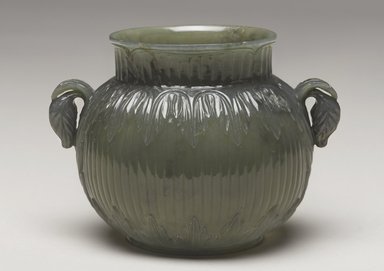
Artist:Unknown
Medium: Carved Jade
Geograhical Locations:
Dates:mid 17th century
Dimensions: at base: 3 1/4 x 2 1/8 in. (8.3 x 5.4 cm)
Museum Location: Asian Galleries, Arts of South Asia, 2nd floor
Accession Number: 78.7
Image: 78.7_PS9.jpg,
Catalogue Description: Small translucent dark green jade jug or jarlet covered with acanthus leaf relief decoration around shoulder and lower part of body over a repeated vertical stripe design on neck and body. Two curved handles in the shape of a downturned acanthus bud. Design on neck is contained in 4 over-lapping petal shapes. Squared-off circular foot contains incised mark of Qianlong (1736-1795). Branch and bud design on sides at handle. Jade vessels carved in this style are believed to have been made in India in the 17th century and then collected by the Chinese emperor Qianlong in the 18th century. They were highly influential in the jade-carving workshops of China, where a "Hindustani" style of jades were produced in the 18th and 19th centuries, borrowing elements of form and surface decoration from Indian traditions. It can be difficult to discern the Indian prototypes from some of the better Chinese imitators, but this piece is generally thought to be Indian because of its extremely fine, thin carving, the naturalism of the acanthus-bud handles, and the mottled, olive-green color of the jade (preferred by Indian connoisseurs but not usually appreciated by the Chinese). Condition: Some surface abrasion on interior and pitting on rim. Natural crack at one side of body near handle. Otherwise good.